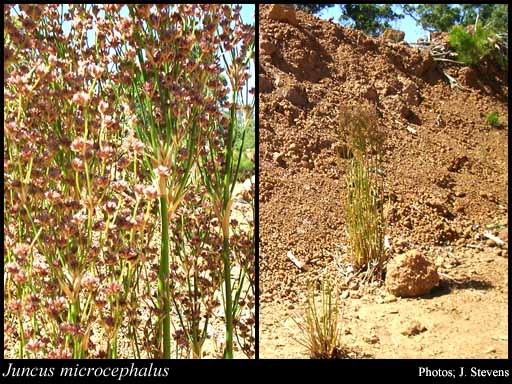- Reference
- Humb., Bonpl. & Kunth, Nov.Gen.Sp.Pl. 1:237 (1816)
- Conservation Code
- Not threatened
- Naturalised Status
- Alien to Western Australia
- Name Status
- Current
Robust rhizomatous, colonial perennial, herb, 0.5-2 m high. Fl. Nov to Dec or Jan to Feb. Clay, sand, often wet. Drains, springs.

Distribution
- IBRA Regions
- Esperance Plains, Jarrah Forest, Swan Coastal Plain, Warren.
- IBRA Subregions
- Dandaragan Plateau, Fitzgerald, Northern Jarrah Forest, Perth, Recherche, Southern Jarrah Forest, Warren.
- IMCRA Regions
- Leeuwin-Naturaliste, WA South Coast.
- Local Government Areas (LGAs)
- Albany, Augusta Margaret River, Bayswater, Bridgetown-Greenbushes, Busselton, Canning, Capel, Chittering, Cockburn, Collie, Dardanup, Denmark, Esperance, Gingin, Gosnells, Kalamunda, Manjimup, Melville, Mundaring, Murray, Nannup, Plantagenet, Serpentine-Jarrahdale, West Arthur.
Management Notes (for the Swan NRM Region)
General Biology. Growth form. Sedge. Life form. Perennial. Reproduction. Seed. Dispersal. Water, machinery.
Notes. A polymorphic, highly variable neotropical species. Occurs in naturally disturbed wetlands and rivers. Rapidly colonises silt beds and riparian zones, leading to changes in water flow, erosion of banks and increased siltation. Roots form tubers with swollen cortical parenchyma. Capsules bear hundreds of very small seeds. Germinates in light, but remains dormant in the dark. When seeds mature, flowering stems bend toward the ground with weight, and if growing on stream or wetland bank, capsules become submerged in water, releasing and spreading seed on any current.
Additional information. Origin. Northern America, central Mexico southern America. Similar native species. Juncus holoschoenus.
Suggested method of management and control. Dig out isolated plants. Try treatment as for Juncus acutus - spray 2% glyphosate + wetting agent in late summer/autumn if there is surface water present throughout the rest of the year. In dry conditions apply in spring/early summer. Read the manufacturers' labels and material safety data sheets before using herbicides. For further information consult the Australian Pesticides and Veterinary Medicines Authority to determine the status of permits for your situation or state.
Management Calendar
| Calendar Type | Jan | Feb | Mar | Apr | May | Jun | Jul | Aug | Sep | Oct | Nov | Dec | Comments |
|---|---|---|---|---|---|---|---|---|---|---|---|---|---|
| Active Growth | U | Y | Y | Y | Y | ||||||||
| Germination | |||||||||||||
| Flowering | Y | Y | Y | Y | |||||||||
| Fruiting | U | U | U | ||||||||||
| Optimum Treatment | Y | Y | Y | Y | Y | Y | Y | Y | Depends on water levels |
Legend: Y = Yes, regularly, O = Occasionally, U = Uncertain, referred by others but not confirmed.
References
- Bell, D.T. (1993) The effects of light quality on germination of eight species from sandy habitats in Western Australia. Australian Journal of Botany, 41 (3): 321-326.
- Brown, K. & Brooks, K. (2002) Bushland Weeds: A Practical Guide to their Management. Environmental Weeds Action Network, Greenwood.
- Hussey, B.M.J., Keighery, G.J., Dodd, J., Lloyd, S.G. & Cousens, R.D. (2007) Western Weeds. A guide to the weeds of Western Australia. 2nd Edition. The Plant Protection Society of Western Australia, Victoria Park.
- Piepenbring, M. (2000) Edible tubers formed by roots of Juncus microcephalus Kunth in H.B.K. Journal of Botanical Taxonomy and Geobotany, 111 (7-8): 567 - 570.
- USDA, ARS, National Genetic Resources Program (2009) Germplasm Resources Information Network - (GRIN). National Germplasm Resources Laboratory, Beltsville, Maryland. URL: https://npgsweb.ars-grin.gov/gringlobal/taxon/taxonomysimple.aspx - Accessed October 2009.